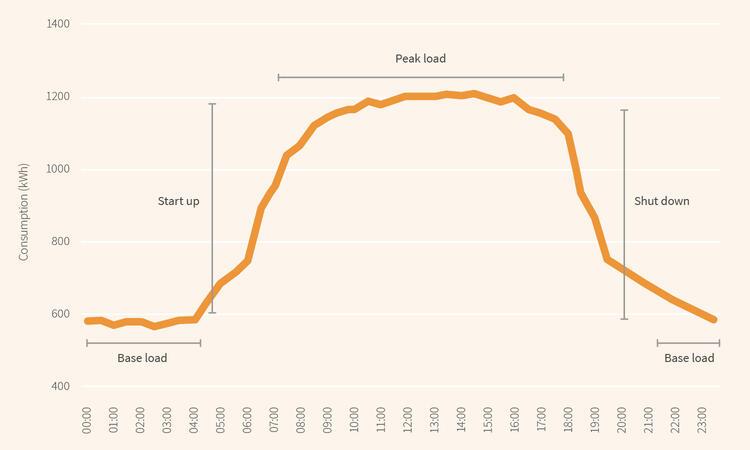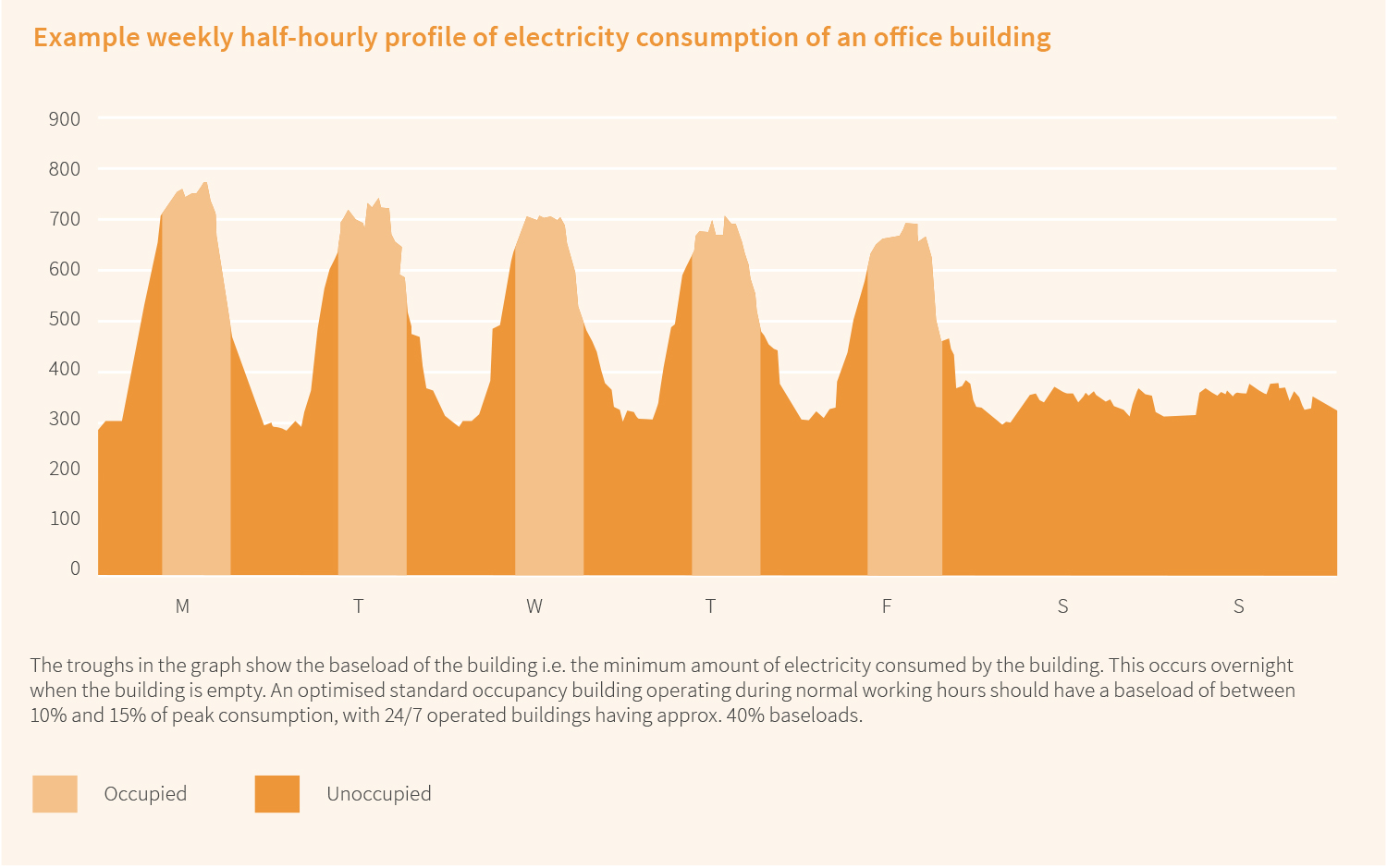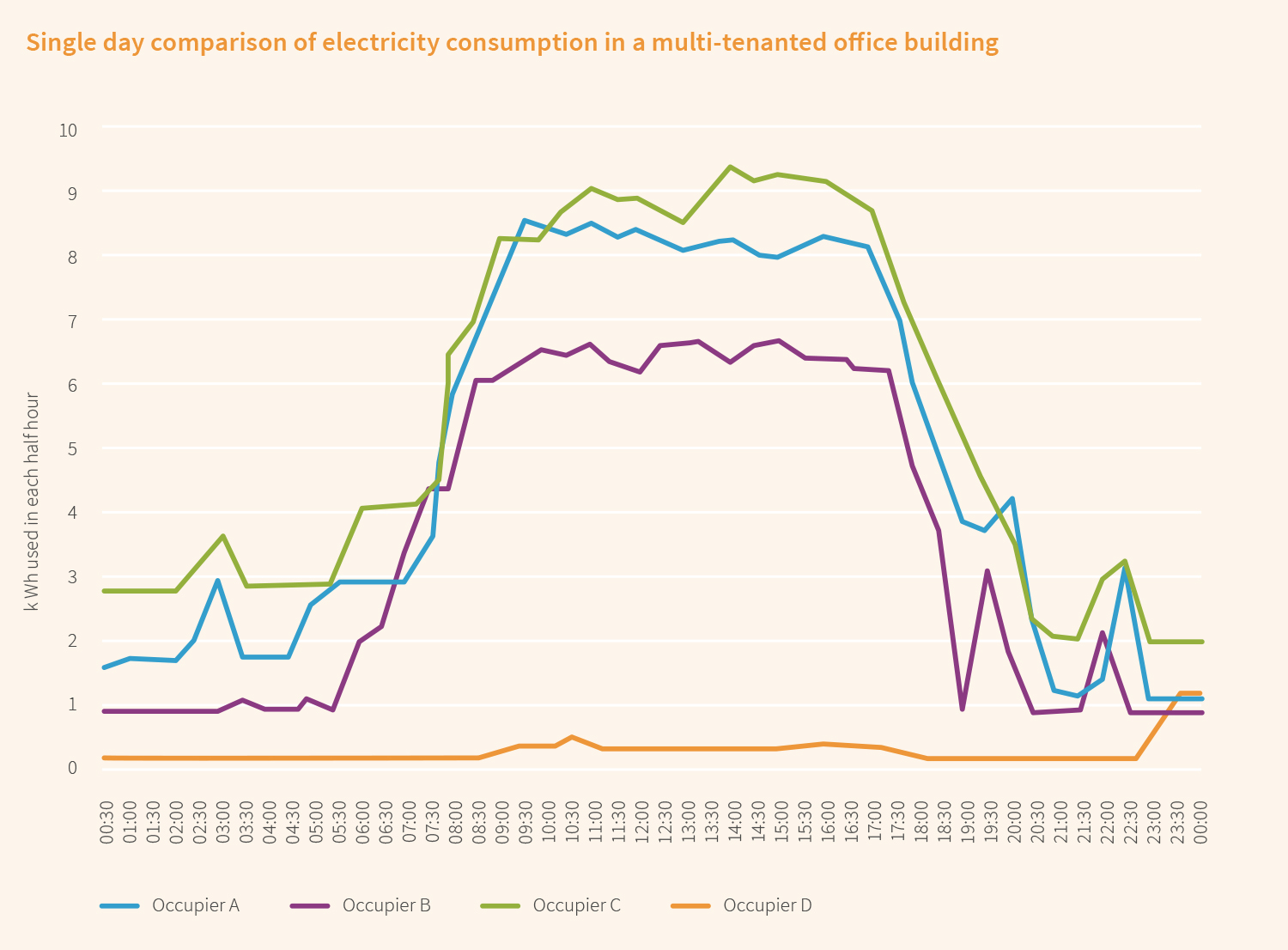GN 4.5: Energy consumption profile
Guidance Note purpose
The purpose of this Guidance Note is to help guide asset managers, property managers and facilities managers in identifying when and where energy is being used and how this information can help to improve a property’s energy performance.
Context
An energy consumption profile provides insight into when, where, and how energy is being consumed within a property. This understanding enables asset, property and facilities managers, and occupiers, to achieve and maintain good energy performance in a building.
An energy consumption profile is a key part of energy management and should be undertaken on an ongoing basis. Building operations change over time as occupants transition in and out of a property, and as different working practices are adopted.
Importance
Understanding when, where and how energy is being consumed, and how to act upon this information, is necessary for identifying and evaluating energy saving opportunities.
Developing a property’s energy consumption profile has a number of benefits. These include:
Understanding patterns in energy consumption
Consumption patterns enable energy managers to identify when energy consuming equipment, for example, lighting or HVAC, activate and de-activate.
This can contribute towards making informed decisions regarding how equipment should be controlled, timed and operated. In addition, anomalies can be identified and investigated to understand whether energy is being wasted due to defective equipment or faulty control settings.
Identifying peak load
Visibility of energy consumption data can identify peaks in demand for energy usage. Peak usage, or peak load, is the highest amount of energy that a consumer draws in a set period.
Understanding peak load is important as it is often used to determine part of a building’s energy bill. As some utility companies charge customers for the peak load in addition to their consumption, using energy at peak load times can result in higher utility bills.
Identifying overnight baseload
The overnight base load refers to the energy consumption that occurs when a property is unoccupied, generally at night. Baseload is considerably lower than a building’s peak load as it represents energy that is being used around the clock.
Certain factors normally affect baseload, for example lighting and HVAC systems, that continue to run outside of a building’s core operating hours. Understanding the baseload is important for identifying where energy is being used. This can inform decisions regarding lowering the baseload and improving a property’s energy efficiency.
Half-hourly data demonstrating an average consumption profile over day of a typical office building

Responsibilities & Interests
The table below summarises the key activities associated with electric vehicle charging provision, and highlights where asset managers, property managers and facilities managers are likely to have a responsibility or specific interest.
- AM - Asset Manager
- PM - Property Manager
- FM - Facilities Manager
1: Establish how much energy is being consumed
Stakeholder:
2: Establish when energy is being consumed
Stakeholder:
3: Establish where energy is being consumed
Stakeholder:
How to
Intro
The development of a property’s energy consumption profile is normally led by a property manager, with input from the facilities manager. Technical support from an energy manager or other competent individual is usually central to the process.
Developing an energy profile involves establishing how much, when and where energy is being consumed.
1: Establish how much energy is being consumed
It is important to maintain good energy consumption records:
- Simple meter readings (recorded in a spreadsheet) or analysis of energy bills can be used to establish annual and monthly energy consumption data.
- Install advanced meters can log consumption data on a half hourly basis, can be remotely read, and have the potential to be transferred to a building energy management system (BEMS) or web portal/platform for interpretation.
In the UK, primary utility electricity meters in most modern or recently refurbished buildings will normally be advanced meters. Half-hourly data can be requested from the utility company.
Other electricity meters, and most gas meters in existing buildings, will normally not be advanced meters and will need to be read manually.
Equipment can be retrofitted to manual meters to enable them to be automatically read, to log data half-hourly, and to communicates data (usually using a mobile phone network) to energy suppliers and/or a building energy management system (BEMS).
2. Establish when energy is being consumed
Energy consumption data is best compared over several periods.
By comparing the energy demand during different periods, it is possible to identify inefficient energy consumption. It may be the case, for example, that there is significant energy demand during unoccupied or out-of-service hours. This may indicate an inefficient use of heating or cooling plant, lighting or other services/equipment.
Through this type of analysis, the following areas should be identified and investigated as part of a regular process:
- Energy usage patterns.
- Peak usage times.
- Overnight baseload.
Compare how energy demand varies with the weather
Some aspects of energy demand are also weather dependent, for example heating and cooling systems.
Understanding a property’s seasonable energy consumption profile can enable informed decisions regarding setting equipment to align with expected weather changes.
The concept of ‘degree-days’ enables the analysis of a property’s energy-weather dependency, which can contribute towards optimizing a building’s energy efficiency.
Degree days:
- Provide a measure of the severity and duration of cold weather.
- Provide a linear measure of heating and cooling requirement relative to external temperature.
- Are a useful way to establish when heating or cooling equipment are active.
- Contribute to the assessment of energy wastage during periods of cold or hot weather.
Compare how the demand for energy varies over time
Understanding energy usage patterns, peak load and baseload enables the comparison of how the demand for energy varies over time. From this, it is possible to check whether consumption variability meet expectations and/or whether specific interventions can be taken to prevent unnecessary energy use.
The graph below demonstrates an energy consumption profile over a week for a typical office building. The shades of blue indicate occupied and unoccupied hours.
From this analysis, an energy manager can establish whether considerable energy usage is occurring outside of the occupied hours and determine the extent that this can be reduced.
Familiarity with the usual demand profiles can also be helpful in identifying unexpected changes in energy use. Any significant change in the profile of energy demand must be caused by a change in the property, either in the way it is used, or how the central plant is operating.
Example weekly half-hourly profile of electricity consumption of an office building.

3. Establish where energy is being consumed
It is important to establish the range of energy consuming equipment and areas in a property, and to identify the high energy users.
While usage patterns provided by main meters can help users to estimate where energy usage takes place, submeter data can ascertain the exact contribution from specific equipment or areas, for example, server rooms, trading floors, chillers, kitchens.
- Advanced submeters enable the comparison of energy demand for different areas of a building. This can contribute to understand the breakdown of energy and to identifying areas of significant usage and waste.
- Sub-metering data is more powerful if recorded on a half-hourly basis, using advanced metering. This will ultimately allow an energy manager to see exactly when and where energy is being consumed and enabling identification of where improvements can be made.
Occupier profiles
Submetering enables energy managers to compare usage by different occupiers. This can be achieved by comparing individual occupier energy consumption over a set period.
The graph below demonstrates an example of usage patterns across for different occupants over a 24-hour period. Undertaking this type of analysis enables occupier engagement on energy efficiency and can contribute to the identification of energy saving opportunities.
Single day comparison of electricity consumption in a multi-tenanted office building

Related Guidance Notes
The following Guidance Notes contain related information:
- GN2.2: Automating property level data
- GN4.4 Advanced metering
- GN4.6: Undertaking an energy audit
- GN4.7: Setting energy targets
- GN4.9: Energy efficiency improvements
- GN4.12: Energy performance monitoring
- GN5.2: Undertaking a water audit
- GN5.3: Benchmarking water use and setting targets
- GN5.4: Water efficiency improvements
- GN11.2: Engaging Occupiers